1. Ongoing Research Projects
| S.No |
Name of Project |
Name of Scientist |
Year of start |
Name of funding agency |
Budget (lakhs) |
|
1.
|
Establishment of mother plants nursery for Hi-tech planting material for fruit crops
|
Dr. S.K. Pandey
|
2011
|
NHB
|
46.62
|
|
2.
|
Experiential Learning unit setting up of facilities for Entrepreneurship Horticulture
|
Dr. S.K. Pandey
|
2012-2013
|
ICAR
|
32.16
|
|
3.
|
AICRP on improvement of Seed Spices
|
Dr. S.K. Sengupta
|
2009-2010
|
ICAR
|
1.10
|
|
4.
|
Network Research Project on Onion and Garlic
|
Dr. A. Tiwari
|
2008-2009
|
ICAR
|
15.00
|
|
5.
|
AICRP on Arid Zone Fruits
|
Dr. C.S. Pandey
|
2009-2010
|
ICAR
|
17.00
|
|
6.
|
AICRP on Vegetable Crops
|
Dr. A.K. Naidu
|
1970-1971
|
ICAR
|
70.67
|
|
7.
|
GOI, NHM (CSS)
|
Dr. P.K. Jain
|
1995-1996
|
GOI
|
40.73
|
2. Product testing trial
The following product testing trials were/will be conducted in the year of 2013-14.
- Testing of seven Bottle ground verities of UPL
- Bio-efficacy of super Auskelp on chilli.
- Bio-efficacy of Tomato Auskelp on chilli.
- Bio-efficacy and phyto-toxic of Alitte BOWT (FosetylA 80% WP against fruit rot and
bacterial life blight on pomegranate )
- Bio-efficacy and phyto-toxic of Melody Duo (Iprovalicarb5.5%+Prop[inabe61.25% WP
against fruit rot (Phytopthora) on pomegranate)
- Bio-efficacy and phyto-toxic of Folicus 430SC (TebuconazolE430Sc) against purple
blotch and Stemphylium blight on onion.
Research Achievements
Evaluation of Germplasm
Collection and evaluation of germplasm plays an important role in crop improvement,
as it provides the knowledge and pattern of variability in genetic stock. The germplasm
collection program in different vegetable crops viz., chilli, tomato, brinjal, dolichos
bean, sweet potato, french bean, fenugreek was initiated in the year 1972.
| Crop |
Number of germplasms |
| Chilli |
25
|
|
Tomato
|
50
|
|
Dolichos bean
|
25
|
|
Brinjal
|
40
|
|
Onion
|
36
|
|
Garlic
|
32
|
|
Bottle gourd
|
25
|
|
Fenugreek
|
70
|
|
Coriander
|
40
|
In chillies yield of red ripe; dry chillies per plant ranged from 150-350 g. On
the basis of yield, genotypes were grouped in three categories nearly 50 per cent
of the lines were high yielding.
In dolichos bean, early flowering and fruiting genotypes were JDL-46, JDL-53, JDL-73,
JDL-78 and JDL-85. The maximum yield of fruit was obtained in the genotype JDL 77.
These genotypes may be utilized in the improvement of yield in dolichos bean. Although
yield potential of JDL-53 was observed to be comparatively low but due to earliness,
it has been recommended for cultivation.
Five genotypes of brinjal viz. JB54-1, JB-67, JB53-2, JB-77 and JB-72 recorded higher
marketable yield of fruits per plant (1610-1350g).
The average bulb weight of garlic ranged from 30g to 40.3g, number of cloves/bulb
ranged from 13.2 in IC 49350 to 31.4 in IC 35231. Higher marketable bulb yield of
79.44 q/ha and 71.22q/ha was noted in HG-1 and local selection respectively.
In bottle gourd genotype JLS-10 recorded early flowering, while earliest first harvest
was obtained in JLS-15 followed by JLS-19 and JLS-6. Among the long fruited genotypes,
the maximum fruit length was recorded in JLS-39. The maximum yield of round-fruited
genotypes was recorded in JLS-21, JLS-24 JLS-58, JLS-1, JLS-65 and JLS-11.
Varieties Developed by JNKVV
|
S.No.
|
Crop
|
Variety
|
Specific Characters
|
|
|
1. |
Chilli |
Jawahar Mirch-218 |
Kalipeeth × Pusa Jwala was released in 1986 by the state variety release committee.
It is an early maturing and high yielding variety with wide adaptability. Plants
are dwarf (50-55cm), spreading with light green foliage. Fruits are long, thin,
bright green; good transport quality; tolerant to leaf curl and fruit rot; first
picking starts in 100-105 days after sowing. This variety has yield potential of
90-100 q/ha. It is suitable as a spice. |
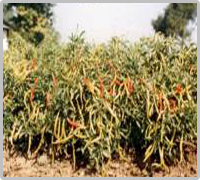
|
|
2. |
- |
Jawahar Mirch-283 |
It is a high temperature (37-40°C) tolerant variety developed through selection
from local genotype collected from adjoining areas of Jabalpur. Plants are dwarf
(40-45 cm), bushy with 7-9 primary branches with dense foliage cover. The fruits
are straight, firm, medium in length, thin (2.5-3.5 cm girth in the middle) and
dark green in the colour. The red ripe fruits are bright. It is suitable for green
picking. It has been released in 1997 for cultivation. |
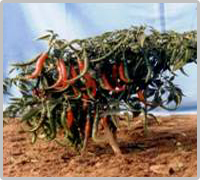
|
|
3. |
Brinjal |
Jawahar Brinjal-64 |
It is a small-fruited variety with high yield potential which has been developed
and released in the year 2000. It is an early maturing variety tolerant to phomopsis
fruit rot disease. |
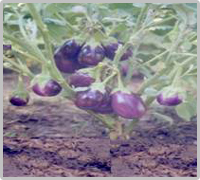
|
|
4. |
- |
Jawahar Brinjal-15 |
It is an excellent variety having high yielding potential and high TSS value (5.05%)
which is developed by selection; this variety is suitable for processing with long
shelf life . |
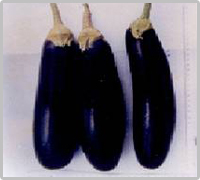
|
|
5. |
Tomato |
Jawahar Tomato-99 |
It is a small-fruited variety with high yield potential which has been developed
and released in the year 2000. It is an early maturing variety tolerant to phomopsis
fruit rot disease. |
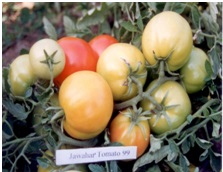
|
Pre Released Varities
|
S.No.
|
Crop
|
Varieties/ hybrids
|
Specific Characters
|
|
|
1. |
Okra |
Jawahar Okra Hybrid-1
|
Fruits medium in size, high yielding and tolerant to YVMV. |
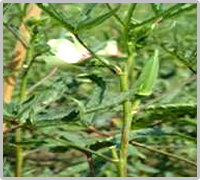
|
| . |
. |
Jawahar Okra Hybrid- 2
|
Fruits are medium in size with resistance to YVMV |
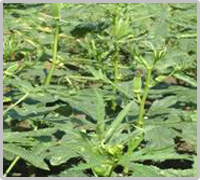
|
|
2. |
CROP - Tomato
|
Jawahar Tomato Hybrid -1 |
It is indeterminate having medium maturity with resistance to TLCV |
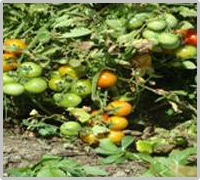
|
|
3. |
CROP - Bottle Gourd
|
Variety - Jawahar bottle gourd Hybrid-1 |
Round large fruited, high yielding and suitable for all seasons. |
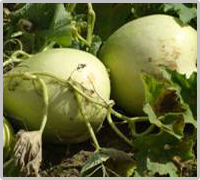
|
|
4. |
Brinjal
|
Jawahar Brinjal Hybrid-1 |
Early, fruits are long, shiny, high yielding and tolerant to phomopsis blight. |

|
|
5. |
Dolichos bean
|
Jawahar Sem- 53 |
It has been developed through selection. It is extra early and high yielding. |
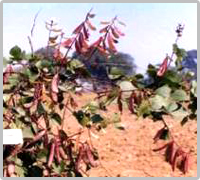
|
| . |
Jawahar Sem 79-1
|
Jawahar Sem- 53 |
It has been developed through selection. It is medium maturing and suitable for
pickle making. Pole type- pods are flat and creamy white, high yielding. It has
been recommended for release by the SVRC. |
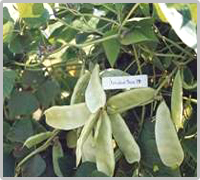
|
|
6. |
French Bean
|
Jawahar French bean – 1 (JFB 99-1) |
Developed from a cross between Arka Komal × JPV24. It is Early type and first picking
is done at 60 DAS. Plant is bush type with 4-5 branches and 40-60 cm height. Leaves
are medium & green in colour. Pods are green, straight, flattish round, meaty, 12-15
cm length and 0.8-1.1cm width. Marketable pod yield is 100-110q/ha. |
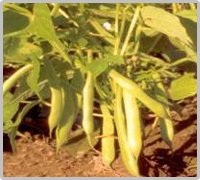
|
With the start of improvement work of vegetable crops, the department developed
46 hybrids of four crops out of which following hybrids are in the AICRP at different
stages of evaluation.
|
S. No.
|
Crop
|
Hybrid
|
AICRP Trial
|
|
1
|
Okra
|
J. Hybrid-1
|
AVT II
|
|
2
|
Okra
|
J. Okra Hybrid-2
|
AVT I
|
|
3
|
Tomato
|
J. Tomato Hybrid-1
|
AVT I
|
|
4
|
Bottle gourd
|
J. Bottle gourd Hybrid-1
|
AVT I
|
|
5
|
Brinjal
|
J. Brinjal Hybrid-1
|
AVT I
|
Improved Varieties proposed for inclusion in the trials 2013-14
|
S. No.
|
Crop
|
Variety proposed for inclusion in the trials
|
Proposed for AICRP Trials
|
|
1
|
Okra
|
Jawahar Bhindi-1
|
IET
|
|
2
|
Bottle gourd
|
Jawahar Gol Lauki-1
|
IET
|
|
3
|
Brinjal
|
Jawahar Brinjal-16
|
IET
|
Germplasm Conservation
Contributed 183 lines of Dolichos bean to National Bureau of Plant Genetic Resources
(NBPGR), New Delhi for conservation.
Significant Achievements (2014-15)
All India Co-ordinated Research Project on Vegetable Crops
- improvement technology : The experiment on integrated plant nutrient
management in Broccoli cv. Green Magic grown during Rabi season on medium black
soil, it was concluded that application of poultry manure @2.5 t/ha + half NPK rec.(60:40:30
kg/ha) at final preparation the maximum head yield (205.02 q/ha) and B:C ratio (4.58)
. Hence it recommended as INM package for broccoli in Jabalpur condition of Zone
–VII
- Seed technology: Application of Azospirillum @5kg/ha along with
the recommended dose of NPK (100:60:50 kg/ha) has been found effective for obtaining
highest seed yield in brinjal cultivar Jawahar -64 under Jabalpur conditions
All India Network Research Project on Onion and Garlic
Crop improvement:
- Collection, Evaluation and Conservation of Onion and Garlic Germplasm:
Surveyed and collected 29 germplasm of onion and 30 germplasm of garlic from various
places like Mandsour, Ratlam, Neemuch, Betul, Chhindwara. Onion germplasm were conserved
and taken for seed production. Garlic germplasm were evaluated for economic characteristics.
- Varietal Evaluation Trial: In Onion IET Kharif – 09, Onion IET
Kharif Hybrids - 07, Onion AVT-I Kharif -13, Onion AVT-I Kharif Hybrids – 11, Onion
AVT-II Kharif – 13, Onion IET rabi- 09, Onion IET rabi Hybrids – 7, AVT-I rabi-
12, AVT-I rabi for Hybrids – 11, Onion AVT-II rabi – 12 and In garlic, IET rabi
– 07 and AVT –II rabi – 07 were evaluated for important characters.
Crop production:
- Effect of salicylic acid on onion production - The maximum plant
height, neck thickness, ‘A’ grade bulbs, ‘C’ grade bulbs, % bolters as well as %
doubles and the minimum thrips count were observed in foliar application of Salicylic
acid at 30DAS and 2nd spray at 30 DAT. The treatment foliar application of Salicylic
acid at 30DAS and 2nd spray at 30 DAT and 3rd spray at 45 DAT recorded the maximum
equatorial diameter (42.470 mm), polar diameter (40.550 mm) and total bulb yield
(18.330).
- Effect of micronutrients application on yield and storage quality of onion:
The treatment Soil application of Zinc @ 2.0kg/ha recorded the maximum average
bulb weight (40.58%) and total bulb yield (42.08 t/ha) while, foliar application
of Zinc @ 0.5% at 30 and 45 DAT recorded the highest marketable bulb yield (42.21
t/ha).
Crop protection:
- Disease Management : 0.25% Mancozeb at 30DAT, 0.1% Propiconazole
at 45 DAT and 0.25% COC at 60DAT) was observed to be the most superior treatment
among the other treatments with regard to minimum incidence of stemphyllium blight
(8.61), purple blotch (17.12), anthracnose (5.22) and the maximum total yield (44.47).
All India Co-ordinate Research Project on Arid Zone Fruits
- Survey and collection of Germplasm : The survey was conducted to collect
elite types from natural population of mandate fruit crops in potential areas of
Madhya Pradesh. 04 germplasm of Bael, 03 germplasm of Tamarind, 02 germplasm of
Jamun and 03 germplasm of custard apple marked promising on the basis of desirable
characters.
- Varietal trial : During the varietal trial of seven cultivars of
Bael viz., Goma yashi, NB-5, NB-7, NB-9, NB-17, CISH-1,CISH-2. The maximum height,
stem diameter and spread of plant was recorded in NB-17 followed by Goma Yashi.
In varietal trials of Tamarind variety Goma Prateek recorded highest growth performance
with respect to height, stem diameter and spread of plant.
- Varietal collection: Varietal collection of mandate crops i.e.
Bael, Custard Apple, Jamun & Tamarind was made from different centres/Universities
i.e. from IIHR, Bangalore , Karnataka ; M.P.K..V. Rahuri, Maharashtra; NDUAT, Kumarganj,
Faizabad U.P.; CISH, Lucknow, U.P.; CHES, Godhra, Gujarat; UAS, Dharwad and KRC
College of Horticulture, Arabhavi, Karnataka
- Integrated Nutrient Management in Custard Apple: The INM trial
in custard apple cv. Arka Sahan was carried out to standardize the dose of NPK with
organic manures and biofertilizers. The experiment was laid out with ten treatments
of different combinations in Randomized Block Design (RBD) replicated thrice with
two plant unit. Among the various INM treatments in custard apple cv. Arka Sahan
the treatment combination of 75% RDF+NPK+Vermi compost@ 2kg/plant +AZB and PSB on
plant height, stem diameter and spread of plant (N-S and E-W).
- Survey and surveillance of key diseases of arid zone crops : During
survey cercospora leaf spot in custard apple, bacterial leaf spot in Bael and fungal
leaf spot in Jamun was observed at each location.
- Screening of germplasm of arid zone fruits for resistance against different
diseases : In screening against the diseases of mandate crops in var. Goma
Yashi of bael found maximum susceptible against bacterial leaf spot & in Jamun var.
Soundhatti-45 was found most susceptible against fungal leaf spot disease.
- Identification of Microorganism causing post harvest diseases :
Rhizopus sp. and Rhizoctonia solani were identified in fruits of custard apple and
bael respectively as micro organism causing post harvest diseases.
High-tech Horticulture
Developed suitable agro-techniques for vegetables (tomato and bell pepper) and flowers
(Gerbera and Roses) production technology under protected cultivation. The main
objective of the experiential learning scheme was “Earn While You Learn’' on Hi-tech
Poly house for off-season cultivation of vegetables and flower production technologies
to train the students to work on modern aspects of high tech cultivation. Technology
would help to develop skill and entrepreneurship qualities in the students in the
area of cut flowers and vegetable production. This would generate revenue for the
project as well as for the university. Technology will supply the necessary off-season
vegetables which will be used for processing in the proposed Experiential Learning
Scheme of the Fruits and Vegetables Processing.
Agro-Techniques Developed for M.P.
i. Package of practices for cultivation of capsicum in polyhouse.
ii. Package of practices for cultivation of gerbera in polyhouse.
iii. Weed management in onion through application of Oxyfluorfen @ 1.6 ml/l of water
as pre and post emergence herbicide.
iv. In okra, application of GA or NAA @ 100ppm at 30 and 50 DAS is recommended for
higher seed yield (5.87 & 5.67q/ha), germination (82.82 & 70.64%) and seed
vigour index (10.96 & 10.0) respectively.
v. In okra, seed treatment with Trichoderma (5 g / kg seed) showed highest
seed yield (6.10q / ha).
vi. In tomato, variety JT-99, application of FYM @ 10t / ha + Azotobactor 5kg +
NPK 120:60:80+S@25 kg / ha + Foliar spray of 100ppm mixture of all micronutrient
(Zn, B, Mo, Fe, Cu & Mn) after 30 DAT gave maximum yield (341.45q/ha & B:C
ratio of 2.66:1.
vii. In carrot variety Deshi Red, production of 286.84 q / ha with B:C ratio of
4.62:1 was obtained with application of FYM @ 10t + ½ RDF i.e. 30:40:37.5 kg NPK
/ ha. This package reduced 50% costs of chemical fertilizers.
viii. In cowpea, variety Kashi Kanchan, application of Vermicompost @ 5t / ha +
½ RDF (34:60:37.5 kg NPK / ha) gave average pod yield of 77.18 q/ha with B:C ratio
of 1.52:1 with net return of Rs. 14,240.
ix. In tomato variety JT-99 application of manganese, as manganese sulphate @ 100
ppm at 30 DAT followed by 2 sprays at 10 days interval gave fruit yield of 304.1
q/ ha with B:C ratio of 2.29:1
x. Established high density orchard of mango cv. Amrapali with different spacing
viz., 5 m × 2.5 m and 2.5 × 2.5 m.
xi. Application of oxyfluorfen 23.5% EC before planting + one hand weeding at 40-60
days after transplanting (DOGR recommended practices) was found superior in terms
of marketable bulb yield, WCE and B:C ratio.
Seed Production
i. Breeder seed production of varieties and hybrids as per indent of GOI.
ii. Nucleus, Breeder and TL seeds of different vegetable varieties.
iii. Maintenance breeding of varieties and parental lines of vegetables.
iv. Production of Jawahar seed of different vegetable crop varieties.